# Masters of the Green: The Black Caddies of AugustaNational
Arts & Culture
For almost fifty years, they carried the bags of golf legends but also masterminded victories from the tees to the holes. Then, with one decision, their lives shifted, and the legacy of their glory days went unheralded. Finally, that’s changing
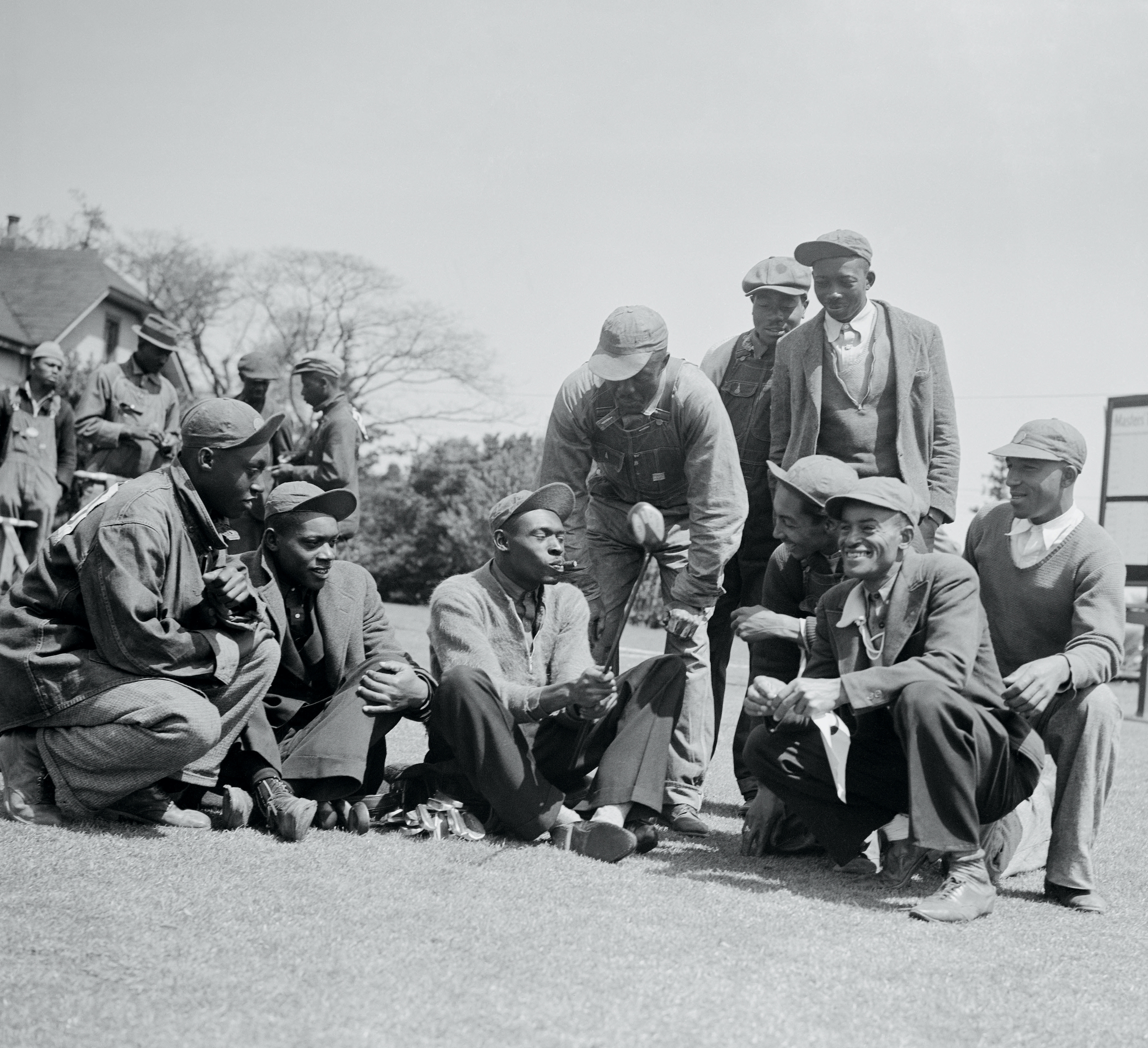
Photo: Bettmann Archive/Getty Images
John H. “Stovepipe” Gordon (center) with his fellow caddies at the 1935 tournament.
In a small cardroom at the back of a municipal golf course clubhouse in Augusta, Georgia, a handful of old men gather and reminisce.
*Do you remember when…? How about that time…? What about when Willie Peterson wound up on the cover of* Sports Illustrated *back in seventy-two? Wasn’t that something?*
All prompts, meant to bring back sweet memories. As they deal cards, the men talk about their golf games and trade good-natured jabs. They have known one another for more than sixty years, gave one another their nicknames.
Jim “Big Boy” Dent. Robert “Cigarette” Jones. Tommy “Burnt Biscuits” Bennett. Ike “Stabber” Choice.
As long as ailments don’t keep them confined to the house, they can be found here a couple of days a week, playing bid whist, ribbing one another, and recalling the days when they were part of Augusta National Golf Club’s all-Black caddie corps, which players were required to use during the annual spring Masters Tournament. From the competition’s inception in 1934, the caddies—born of Augusta and attuned to the land—could be a golfer’s secret weapon coming around Amen Corner or for surviving other notoriously tricky holes like No. 4, Flowering Crab Apple, or No. 10, Camellia.
These men were no beasts of burden, but talented prognosticators who turned a racist policy, rooted in subjugation, into a livelihood and a source of esteem—one that, ironically, first added diversity to the game of golf. Men like Willie Peterson, who was on the bag for five of Jack Nicklaus’s six Masters victories. Or Willie “Cemetery” Perteet, President Dwight D. Eisenhower’s personal caddie at Augusta National during the fifties. When the club bent to pressure in 1982 and dropped the ban on outside caddies, the change rocked the corps—many of its members, including those who counted on that crucial tournament paycheck to tide them over till the seasonal club reopened in October, had to look for other work.
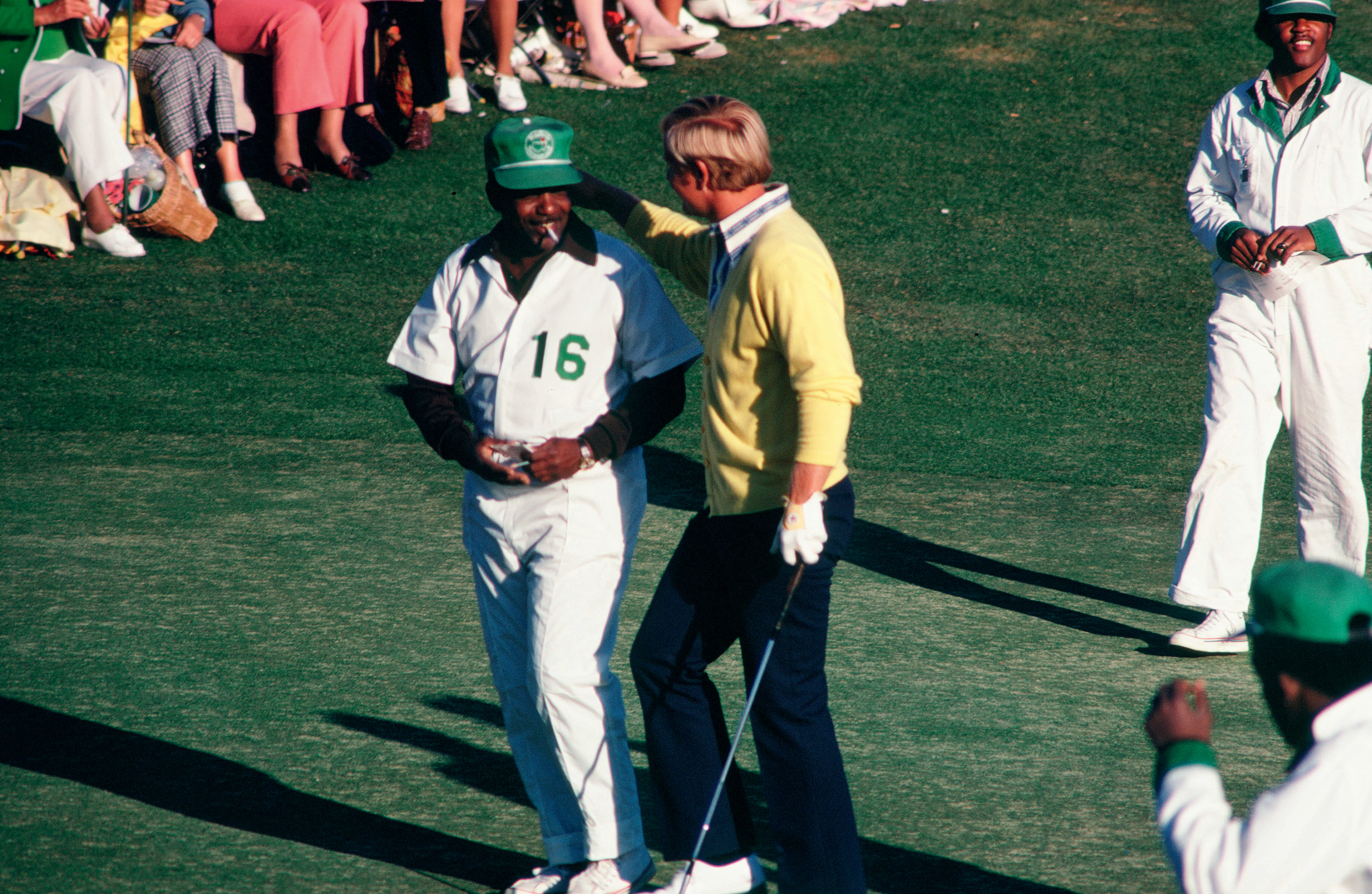
Photo: Augusta National/Getty Images
Willie Peterson and Jack Nicklaus walk the greens in 1973.
In the four decades since, recognition for the pivotal part these men played in the game, until recently, scarcely existed. Even today, they aren’t heralded in the Augusta Museum of History, or mentioned in any of the historical milestones or records on the Masters’ website. But as their numbers dwindle—of the seventy-six caddies enlisted in 1982, only twenty or so are still living—they’re at long last beginning to be honored as what many of yesteryear’s golfers always knew them to be: the Pride of Augusta. An elite group of men who changed the game forever.
---
For thousands of years, the Savannah River’s overflowing waters dumped sand, silt, and detritus onto what would one day become Augusta, leaving fertile soil in their wake. By 1858, three hundred or so particularly arable acres landed in the hands of Louis Mathieu Edouard Berckmans and his son Prosper Jules Alphonse, Belgian immigrants and horticulturists with an interest in fruit and ornamental trees and shrubs. All told, the Berckmans cultivated more than three hundred varieties of peach trees alone and grew a million-plus fruit trees, turning Berckmans Nursery into the first large-scale plant source of its kind in the Southeast. A “horticulture Mecca,” heralded the American Pomological Society, “serving the entire nation.” Folks around Augusta simply called it “Fruitland.”
More than seventy years later, in 1931, the Georgia-born golf champion Bobby Jones and his partner, Clifford Roberts, a Wall Street investment banker, bought the nursery’s spread with plans to fashion a golf course from its landscape. Fruitland Manor became the clubhouse of the new Augusta National Golf Club. Many of the plant varieties the Berckmans developed and improved still grow on Augusta National’s meticulously curated grounds.
Immediately south, sandwiched between the Augusta Country Club and a campus of what is now Augusta University, lies Sand Hills, a Black neighborhood listed on the National Register of Historic Places where most of the caddies grew up. Much of their lives back then took place there “up on the hill,” three miles from downtown as the crow flies, looming hundreds of feet above the then flood-prone city. Close enough to the city’s seats of power that the residents could work in them, even if they could not walk through their front doors. Still, the community felt like “one big family,” recalls Jim Dent, filled with adults who cared about his well-being and corrected his wrongdoings. But “the grandfather of caddies” came from even closer: Fruitland itself.
Arnold Palmer with Nathaniel “Iron Man” Avery, alongside other caddies, in 1965.
Willie Lee Stokes was born in 1920 on a parcel of the property where his family tended cotton and corn. Eleven years later, in need of work, he headed to the golf course under construction, where men were hauling away trees and reshaping the terrain, making way for hazards and bunkers. “I remember cutting down trees on No. 10 and No. 11,” Stokes, who died in 2006, once told the *Augusta Chronicle*. When Augusta National opened, in 1932, Stokes became the personal caddie for Clifford Roberts, who dubbed him “Pappy.”
Stokes’s roots on the land gave him an advantage—he knew how to read the fairways and greens better than others. Take Rae’s Creek. Over the years, Augusta National has modified the course many times, but some water features are too ingrained to redirect. That was the secret of Rae’s, a ten-mile-long stream—up to sixty feet wide and four feet deep—that still cuts through the course. Surrounded by azaleas and dogwoods, the waterway is a major element of the infamous three-hole stretch, filled with hazards, called Amen Corner. Stokes understood that every putt would break toward Rae’s, the pull of gravity sending balls toward the lowest point on the property. Stokes also followed falling water: He became noted for studying how rain streamed across the greens, rendering the nuances of the topography visible.
Augusta National first put on what would come to be called the Masters Tournament in 1934 with its rule in place—attributed to Roberts—that golfers would always be white, and the caddies would always be Black. The segregated course had support from the top: From that same year until 1961, the Professional Golfers’ Association of America had a “Caucasian-only” clause in its bylaws, preventing non-whites from membership and thus from competing on the PGA Tour.
In 1938, the seventeen-year-old Stokes won his first Masters as a caddie for eventual Hall of Famer Henry Picard. He won again in 1948, with Claude Harmon; in 1951 and 1953, with the legendary Ben Hogan; and in 1956, with Jack Burke Jr. Stokes ties with latter-day caddies Steve Williams and Willie Peterson for the greatest number of Masters wins (five), but he remains the only one to do it with four different golfers.
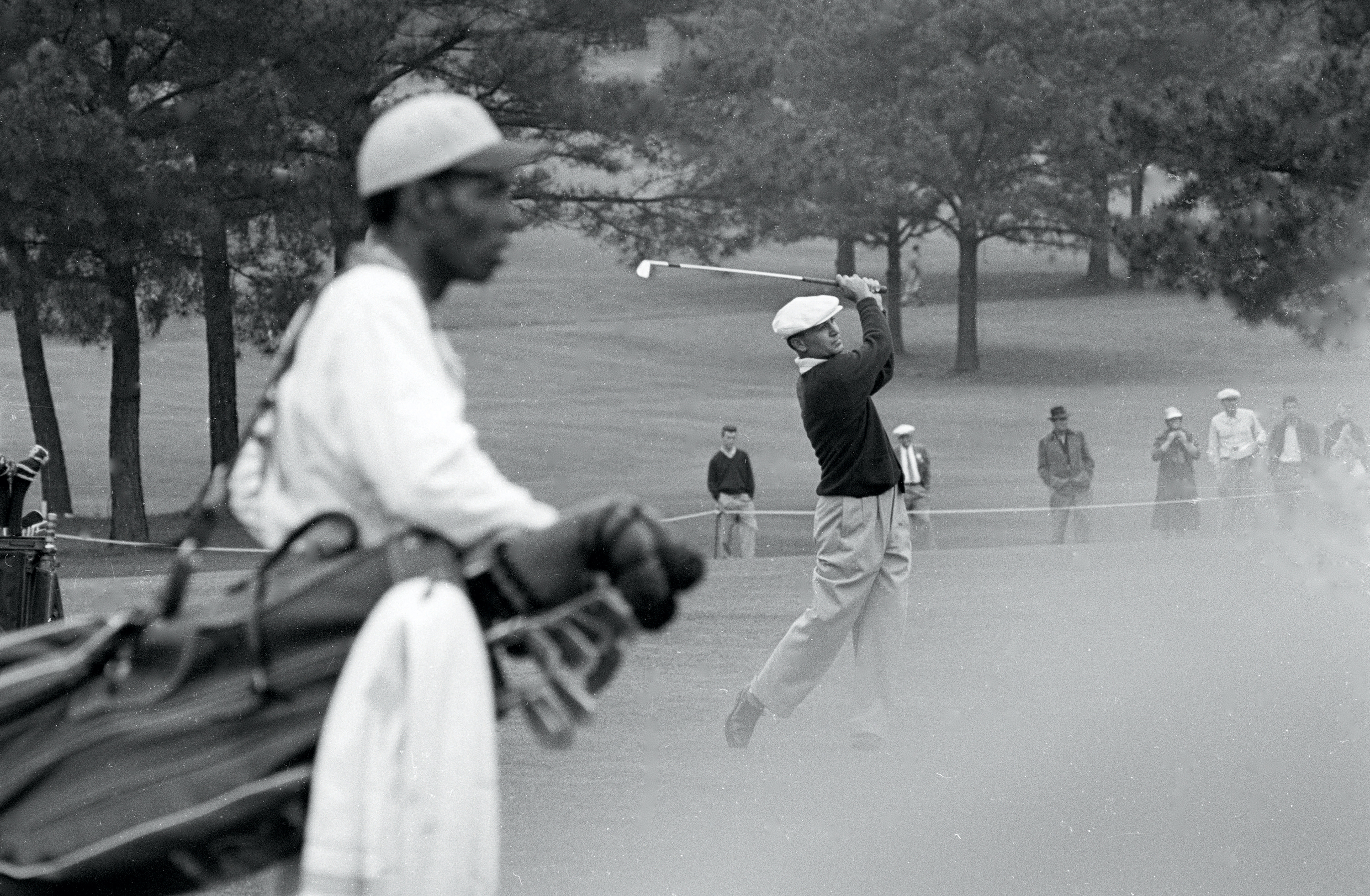
Photo: Mark Kauffman/Getty Images
Ben Hogan at the 1954 Masters with his caddie.
Stokes decided to teach the Black youth in Sand Hills what he knew. Caddying, after all, could provide consistent income and food on the table, even if most chalked the job up as low-skill menial labor, in the realm of domestics and servants. (Back then, even if a caddie had a better assessment of the lay of the land, some golfers only wanted someone to carry their heavy bags over miles of terrain. In those instances, there were just three rules: Show up, keep up, and shut up.) By the time the second generation of caddies was born in the late thirties and early forties, interested boys could attend Pappy Stokes’s Saturday caddie school to learn how to read the greens and anticipate the forces at play in golf. Stokes “was like the godfather of us young kids,” Robert Jones says. “Knew that golf course like the back of his hand.”
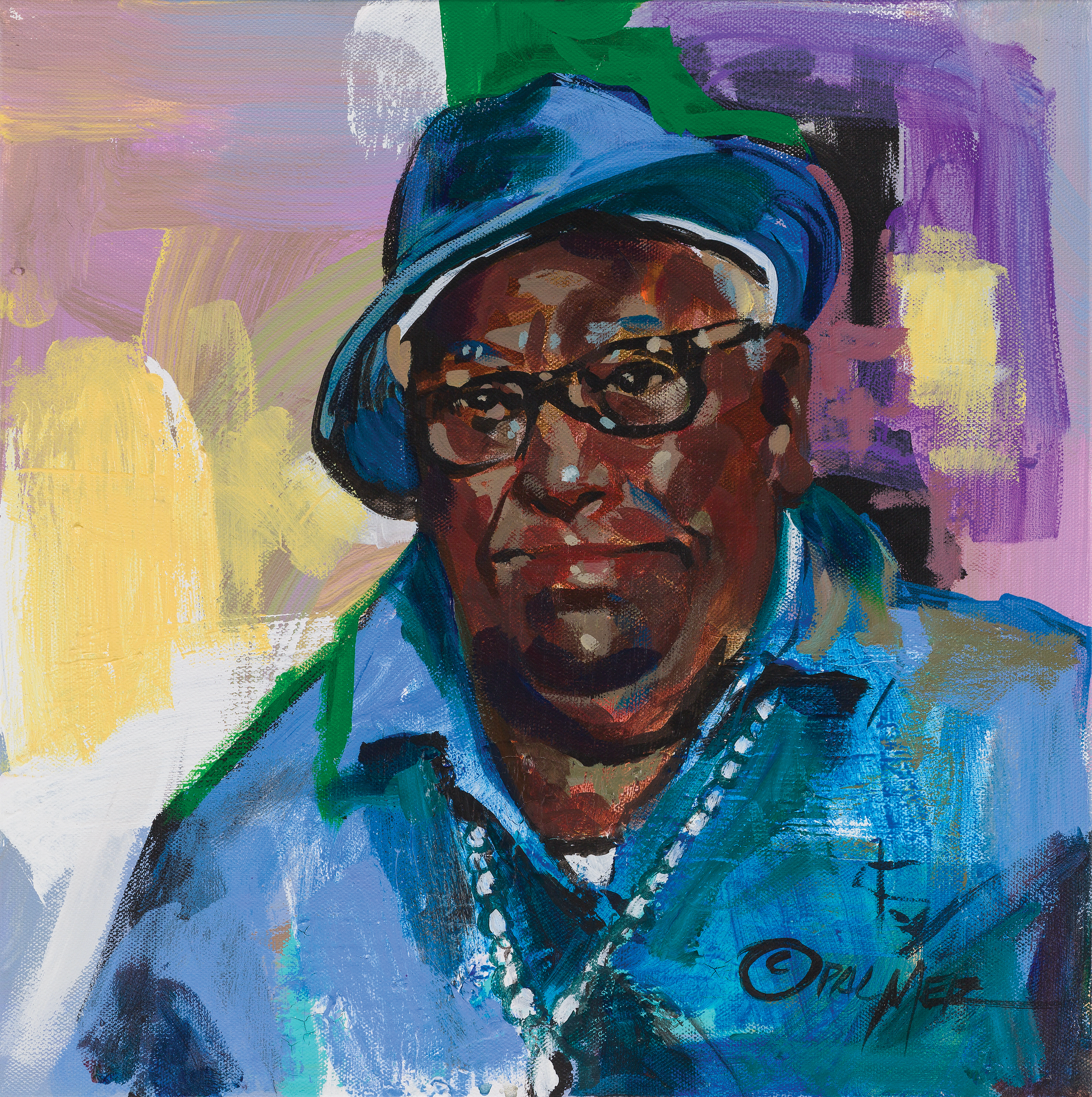
Illustration: Charly Palmer
Robert “Cigarette” Jones. When he wasn’t caddying, Jones played saxophone on tour with James Brown.
Many in Sand Hills worked in one of the area cotton mills, bringing home a mere fifteen or so dollars a week for the hot, backbreaking job. A strong young boy, eager to please and willing to work rain or shine, could make more than that caddying. The kids could also earn around a dollar a day “shagging balls,” golf-speak for chasing balls hit from the practice tee. “Oh, it was fun,” says Jim Dent, who’s now eighty-four, relishing the memory. “We were young. We didn’t know what we were doing. We just enjoyed life. You make five dollars there, and that was a big payday back then.”
But it was also “survival,” Tommy Bennett emphasizes. He was raised by his grandmother after his mother left the city in search of a job. To ease the hardship, Bennett used to sneak onto Augusta National as a boy of eleven to seek out work. Back then he was so small that his body routinely gave out—he didn’t have the energy to finish walking the course. Clubs made of wood and steel weighed more than modern materials like titanium and graphite. A bag could weigh as much as fifty pounds with rain gear. “I was happy to start and happy to finish,” Bennett says. But he put on a little weight and acquired a better attitude. He polished up his manners and learned how to talk to people. Those kinds of skills could come in handy for a caddie—some golfers, frustrated by hazards or bunkers, might throw clubs, or turn the air blue with their cursing.
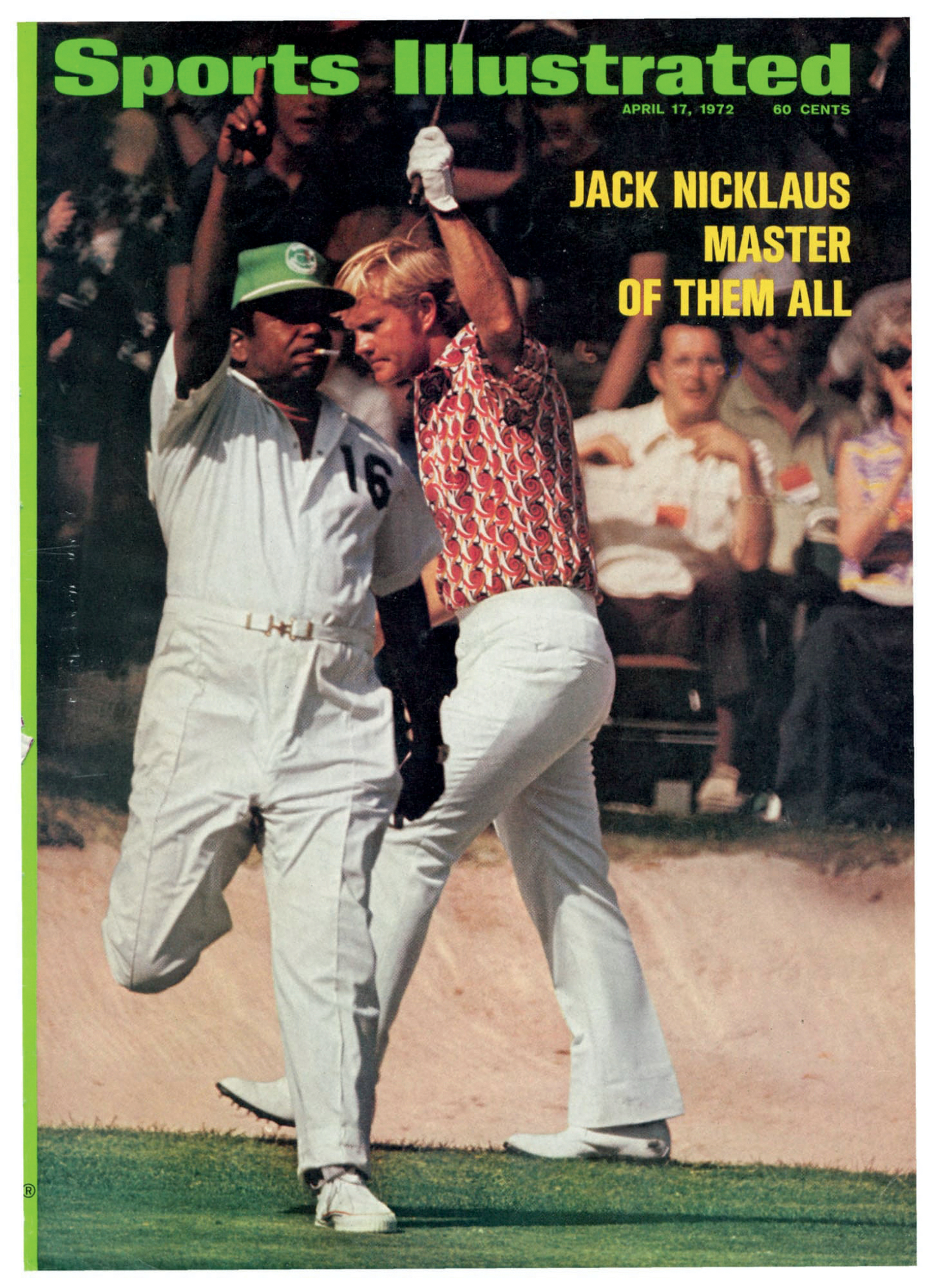
Photo: *Sports Illustrated*
Caddie Willie Peterson and Jack Nicklaus celebrate their Masters win on the 1972 cover of *Sports Illustrated*.
In those early days, ever one step away from being called “boy,” this second generation of caddies became a cast of characters known instead by the nicknames they gave one another, often sparked by funny childhood moments. Bennett got called Burnt Biscuits because he tried to steal one of his grandmother’s biscuits and burned himself so badly, he wound up in the hospital. Jones became Cigarette after he got caught smoking while underage. Dent, though smaller in stature than he used to be, still stands a head above the other caddies, hence Big Boy. Choice’s sobriquet, Stabber, came from his golf technique: He just kept stabbing the ball.
---
The best caddies employ the properties and laws that govern space, time, energy, and matter—but using only their eyes and ears to assess equations that are always changing. Every day they wake up, walk the greens, and run their calculations again, adjusting for a golfer’s fortes, foibles, and equipment. Caddies must be naturalist, physicist, and psychologist, all wrapped in one white coverall.
That dynamic played out during the 1979 Masters, when Jariah “Bubba” Beard was on the bag for Fuzzy Zoeller. “As far as having a plan when I got to Augusta…I had no plan,” Zoeller admitted in *Loopers: The Caddie’s Long Walk*, a 2019 documentary about the worldwide history of caddies, also known as loopers. “\[Beard\] told me where to hit it, where not to hit it…it was like a blind man with a Seeing Eye dog. He led me around that golf course.” By relying on Beard, Zoeller became the last Masters player to win the tournament on his first try—a feat that, without a local caddie, no one can seem to repeat.
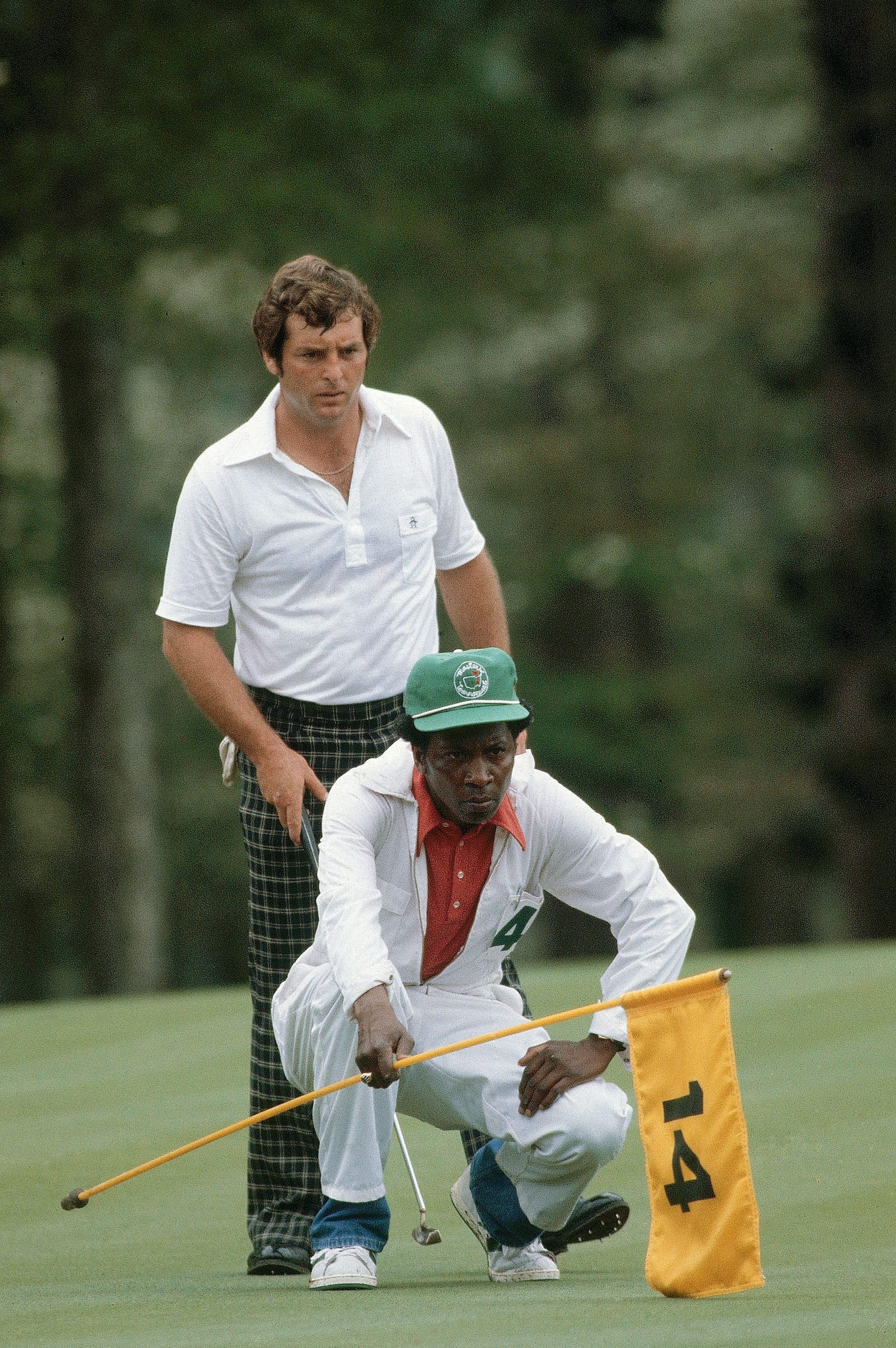
Photo: Augusta National/Getty Images
Jariah “Bubba” Beard advises Fuzzy Zoeller to a Masters win in 1979.
“When I met Carl Jackson, I said, what a gift this is,” recalled Ben Crenshaw in “Vanishing of the Black Caddie,” a news segment that ran in 2021 on the Dallas television station WFAA. “I can’t tell you how many times he helped me in so many instances.” Crenshaw’s 1976 pairing with Jackson, a talented, meticulous, trusted golf companion, became a lifelong working relationship. “It was pretty simple for me,” he says. “I had the best, and I never saw any reason to change whatsoever.” Jackson, who had caddied his first Masters at age fourteen, was on the bag for fifty-four of the tournaments and remained Crenshaw’s caddie until the golfer retired. The two remain tight. Jackson himself said last year would mark his final appearance at Augusta.
“We were the best caddies in the world,” Beard said during his *Loopers* interview, “and we challenged each other \[over\] who could read the greens the best, who could pull the best clubs.” But Beard recounted bitterness alongside the pride. “We were not allowed in the clubhouse,” he says, even after a win. “We were in the caddie pen; that’s where you better stay—‘Boy, you stay in the caddie pen.’” Despite the disrespect, the caddies often used their work as a stepping stone for a better life, for themselves and their families. Jim Dent even parlayed his talents and know-how into becoming a pro golfer himself, in 1966; the game enabled him to send all of his children to college and to buy a house for his aunt Mary, who had raised him after his mother’s death.
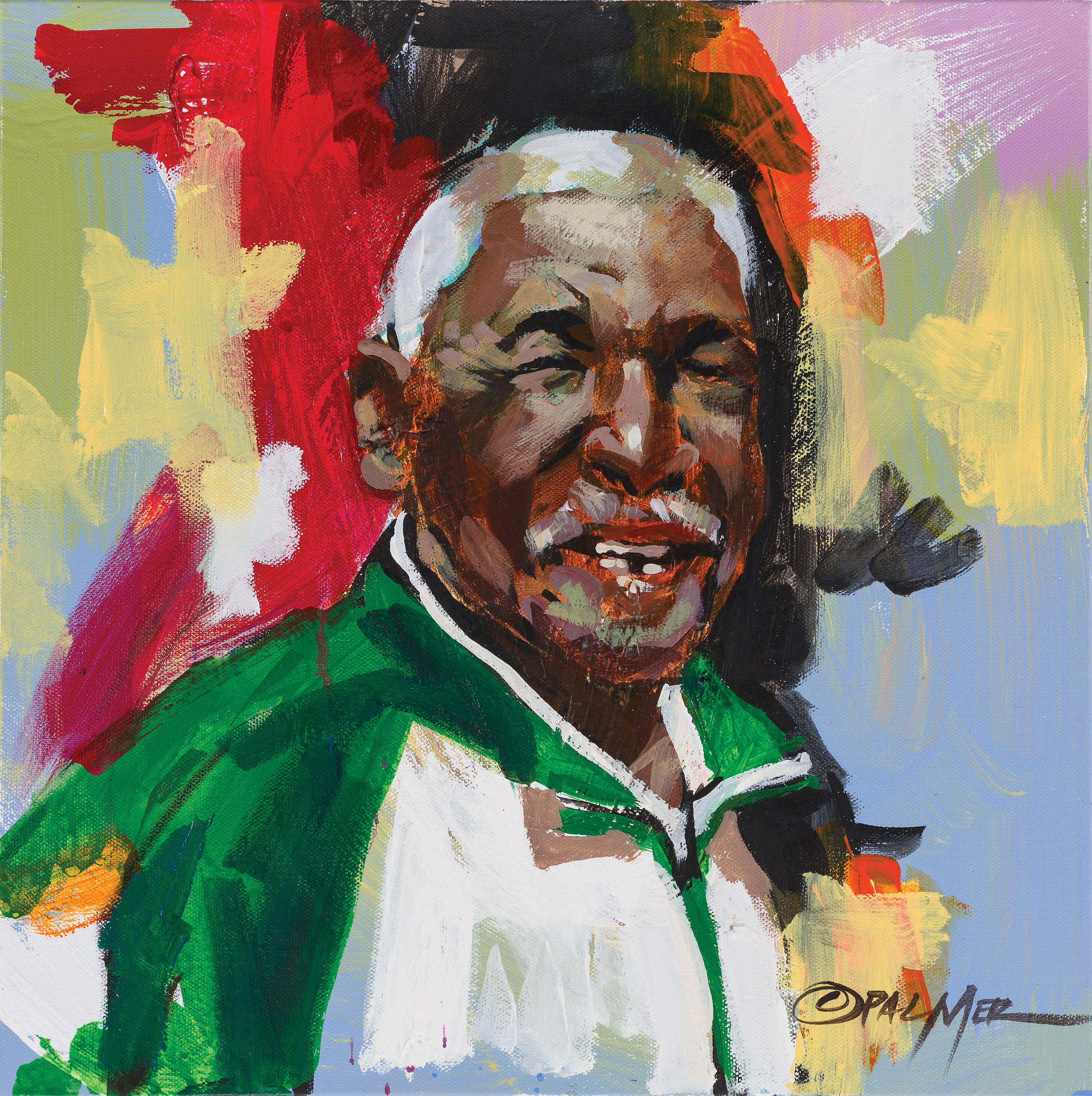
Illustration: Charly Palmer
Jim “Big Boy” Dent. Dent made the leap from caddying to playing, winning twelve tournaments on what was then called the Senior PGA Tour.
In later decades, as golf modernized and television networks broadcast more tournaments, the prize purse swelled, and players began to build personal teams with nutritionists, chefs, psychologists, swing coaches, and caddies who followed them everywhere. Many began to feel that using a local caddie at the Masters instead of someone they collaborated with year-round worked to their detriment. Those complaints came to a head at the 1982 tournament, after a heavy spring rain caused a delay of the third round until Sunday morning. Confusion about the start time left some players without their assigned caddie. One golfer even sent his wife out to shag balls for him.
The PGA players asked Augusta National’s chairman at the time, Hord Hardin, to lift the ban on outside caddies. Hardin, at last, complied.
The next year, only eighteen of the tournament’s eighty-two players used Augusta National’s Black caddies. Not only that, but white caddies, now eager and able to work at the country’s most prestigious course, began to take spots in the course’s corps.
“Money,” Robert Jones says, “changed the world.”
---
Golf and the PGA Tour follow the sun, and after the ban was lifted, some of the younger Black caddies tried to remedy the financial hit by traveling all over the world, advising golfers in Hawaii, Scotland, Japan. When Bennett first hit the road, “we had a van,” he recalls. “We might’ve had ten people in it. It was hard living—there wasn’t no money in it yet.” Some caddies might sleep four to a room.
Bennett made his way to New York. Though he had caddied in eighteen Masters Tournaments, after 1982, he settled for watching the competition on television, “just like everybody else.” He got married, then divorced. At times, he found his way to a course or a driving range, golf his only constant. He never got used to the cold, though, and with no reason to stay, he lit out for Los Angeles and began caddying in Palm Springs. That taste of the game made him want back in. He even caddied for Tiger Woods in Woods’s first Masters, in 1995.
Dent found even more success as a player on the Senior PGA (now Champions) Tour, winning twelve tournaments in the late eighties and early nineties. “When you start at the bottom and work to the top, that makes it taste so good,” Dent says. And he brought some old buddies along, including Jones, who recalls caddying for Dent at a big win in 1983, in Chattanooga. “It was amazing,” says Jones, a talented saxophonist who toured with James Brown when he wasn’t on the bag. “I was glad to be part of it.”
Some of the men, though, past their prime and unwilling to pull up stakes, instead picked up odd jobs or learned a new trade, leaving the fairways forever. Others remained part of Augusta National’s caddie corps. Carl Jackson helped Ben Crenshaw to his two Masters wins, in 1984 and 1995. Charles “Bull” Williams helped George H. W. Bush get around the links—the pair got on so well, bonding over fishing, that they exchanged letters for decades.
The world of caddying, naturally, dramatically changed in the forty years after the Masters ban was lifted. Jones says the biggest check he ever earned was “maybe forty-five hundred or forty-six hundred dollars.” Now, Dent muses, “caddies make more money in one win than a man might see in his lifetime.” Black faces on the greens, too, have all but disappeared. “We only have two Black people on the PGA Tour right now,” Dent points out. “When I was out on tour, we had fourteen at one time.” That’s the irony of the Masters’ all-Black-caddie rule: It was archaic and steeped in racism. And it also, the men admit, granted them entry to a gilded world where they had a chance to learn the game.
---
Living in Augusta means holding these kinds of multiple truths at once. The municipality is a place of great beauty, with flowering plants on every corner underscoring its nickname, Garden City. It also once fostered an atmosphere so oppressive that in 1970 it led to the largest urban uprising in the Deep South during the civil rights era, known as the Augusta Riot. And though the Black caddies played a pivotal part in the city’s reputation as a golf mecca, they went without commemoration or celebration for much of the past four decades.
Even Black residents didn’t always understand the significance of what the caddies had achieved. Leon Maben, who has collected oral histories of the Black caddies since 2019, grew up in downtown Augusta, away from the greens. Sports like baseball, basketball, and football ruled in his section of town. “Golf was for the guys up on the hill,” he explains. “Growing up, we always said, ‘Man, that’s a white man’s sport.’”
But then a business opportunity led the entrepreneur, then based in Atlanta, to the golf course, to sponsor an HBCU clinic and tournament, and there he began to reconsider the history of his Augusta childhood. Now, with the help of a local university student, Courtney Wilson, he interviews any caddies he can find in order to immortalize them. “This is Black history,” he says. “Nowhere else could you say, ‘Black people dominated this facet of the sport for fifty years.’ That’s what makes the story so interesting.” He doesn’t himself play golf, but Maben spends time at the Augusta Municipal Golf Course, known as the Patch, and its clubhouse and cardroom, where the men gather, to hear those stories—while he can.
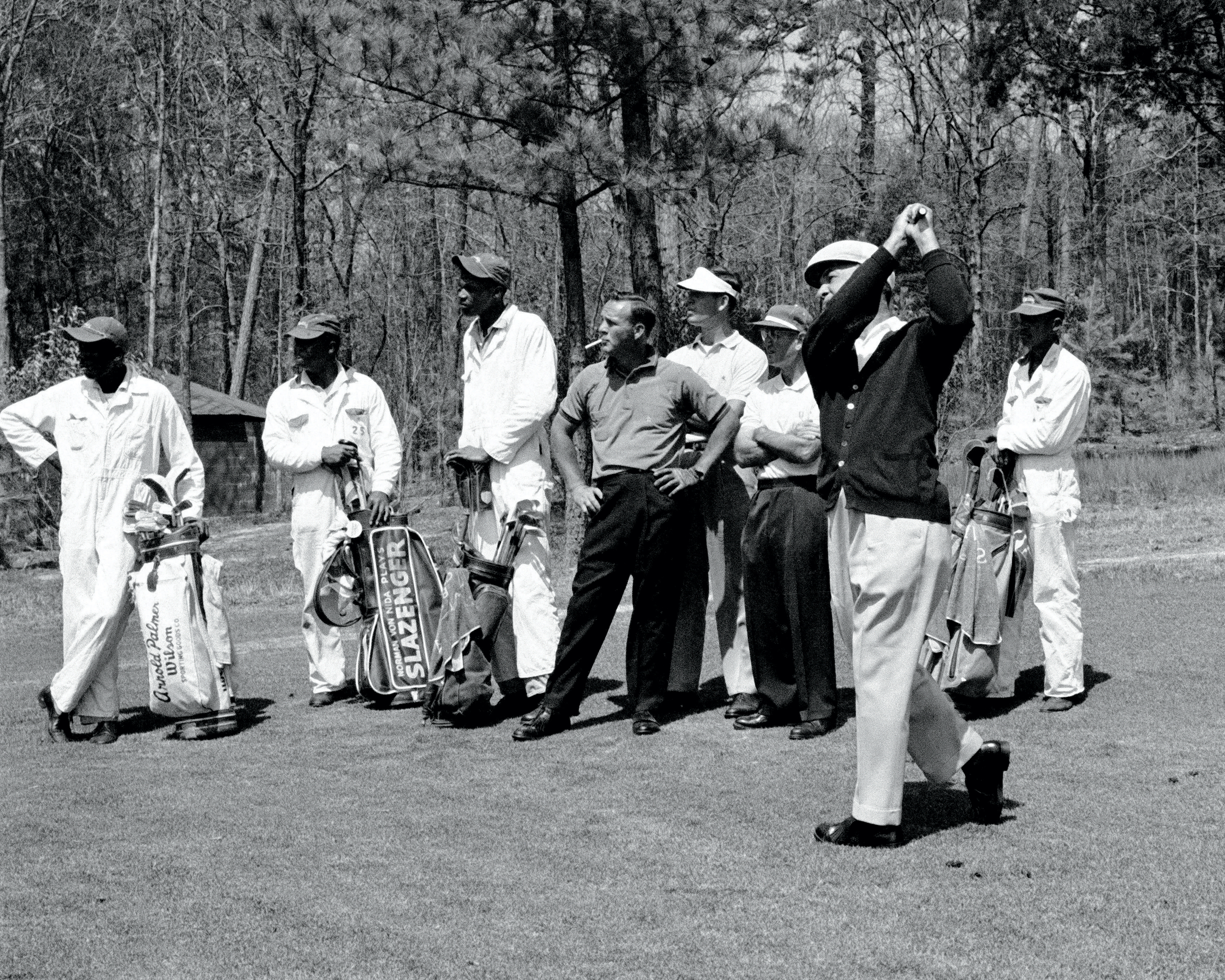
Photo: Augusta National/Getty Images
Palmer, Hogan, and caddies including Nathaniel “Iron Man” Avery.
The numbers of the old-school Black caddies have decreased, and recognition has come but lately. Lee Elder—a former caddie who also broke the Masters race barrier as a player, in 1975—died in 2021, not long after Augusta National and Paine College, an HBCU in Augusta, partnered to create endowed scholarships in his name. In 2023, Jariah Beard succumbed to cancer, and John Luther Elam Jr., a caddie who helped desegregate the Patch, died too.
The small Lucy Craft Laney Museum of Black History and Conference Center, housed in the former Augusta home of a prominent African American educator and activist, has also played a mighty part in recognizing the caddies. Since early 2023, on one weekend a month, the museum has presented “Men on the Bag: The Stories of Augusta’s Famous Black Caddies.” Through the artistic direction of the Augusta Mini Theatre, young actors portray three of the now-deceased iconic caddies. Corey Rogers, the Laney’s executive director, wrote much of the script, taking cues from *Men on the Bag*, a book by Ward Clayton that delves into the caddies’ backstories. Clayton will publish a revised version, *The Legendary Caddies of Augusta National: Inside Stories from Golf ’s Greatest Stage*, in early April.
Even though now-gone greats like George “Fireball” Franklin, Nathaniel “Iron Man” Avery, John H. “Stovepipe” Gordon, and Frank “Marble Eye” Stokes may not appear in golf ’s official record, they are celebrated throughout the museum. Six-foot-tall banners bearing photographs of caddies in their element, or in a moment of victory, frame the room. Here they get to live large.
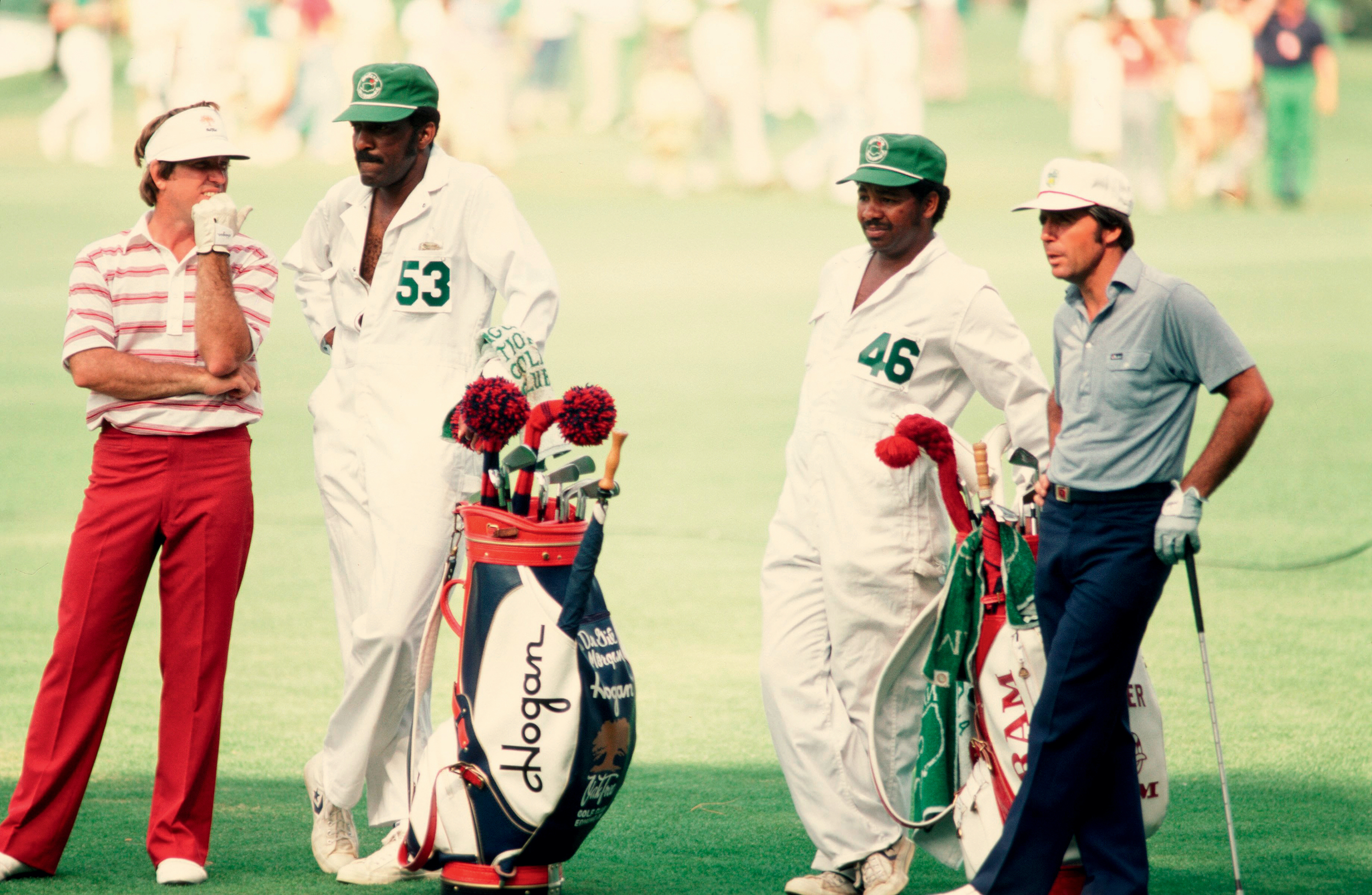
Photo: *Sports Illustrated* via Getty Images
Golfers Gil Morgan and Gary Player with their caddies in 1981.
“The caddies did not let a lot of their surroundings define who they were or allow that to be a ceiling on what they wanted to accomplish,” Rogers says of the images. “Some people think that these men were performing this subservient role by toting the bag. It was much more complex than that. We don’t want people to get the impression that these individuals were downtrodden. Some may be bitter or upset over the treatment and work conditions, but everybody’s story is different, with many emotions in it. We want to tell each individual story and not paint things with a simplistic broad brush.”
But that legacy isn’t limited to the past. When asked about the future of Augusta’s Black golfers, Bennett and Jones both point to one man: André Lacey II.
Lacey is Jim Dent’s grandson, but he insists he came to the game of his own accord, without fully understanding his grandfather’s place as a pioneer. Lacey is now forty; while he grew up “on the hill,” by the time he was born, the heyday of the Black caddies had ended. He learned to play golf at what is now the E. W. Hagler Boys & Girls Club in downtown Augusta. After a rough patch in his twenties led to a divorce, he came back to the game, eventually becoming a PGA of America Golf Associate in 2015.
Now, when he’s not working as an assistant men’s and women’s golf coach at Paine College, his grandfather’s alma mater, he spends much of his time volunteering with youths, making sure they’re aware of all of the business opportunities golf can provide. He runs a PGA Jr. League, a program he started with three kids that has now swelled to some sixty boys and girls at a time. Through his nonprofit, André Frantz Golf, he also provides free instruction, equipment, and other resources to people who want to learn more about the sport, lowering the economic barrier to access. “I take a lot of pride in being an ambassador and spreading the game,” Lacey says. “Golf is a game for everyone to enjoy. I want to help as many people as I can.”
---
The pride of Augusta is a double-headed, sunshine-colored cultivar of *Gelsemium sempervirens*, or what Augusta National Golf Club calls yellow jasmine. Others around these parts call it yellow jessamine.
The Fruitland horticulturists probably introduced the cultivar. Like the caddies and their ancestors, it existed on this land before Augusta National, a Southern plant then shipped around the world. Native to the terrain, it will use any challenge it encounters—fences, a loblolly—to gain a foothold. In the winter, the plant bronzes like a melanated body in the sun. When spring arrives, the buds will be in bloom, alongside the course’s emblematic azaleas, just in time for the Masters, which begin practice rounds in early April.
That week, some fifteen hundred private jets will fly into the city, many of them on a flight path that leads right over the Patch, the propellers close enough for people on the ground to feel their wind. While the crowds surge and roar behind the ropes at Augusta National and a golfer gains a green jacket, André Lacey II will be mentoring local young people and teaching the fundamentals at his Nike Junior Golf Camp nearby.
In his element, Lacey is loose and expressive. Six foot one, sure-footed and graceful, with a radiant smile that seems to amplify the warmth of his voice as he talks to the group in front of him. “There’s no other sport as natural as golf,” Lacey will explain. “That’s why golf transcends from one country to the next. It’s the only life sport, where you can play it at a hundred years old.”
The camp will end at noon, and depending on what the sky looks like, Lacey might head to the Patch afterward, to the beloved clubhouse with its treasured card games. Perhaps he’ll even join the old caddies for a round. “Every day is a good day,” one might remind the other. And as they prepare to play, the private jets will rocket over their heads on their way to somewhere else, the aircraft disappearing beyond the horizon as the Black golfers of Augusta shoulder their bags and head toward the first tee.